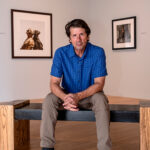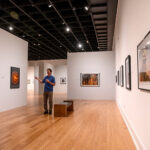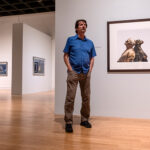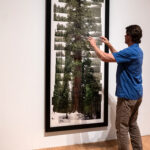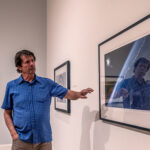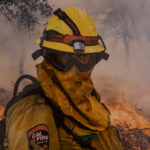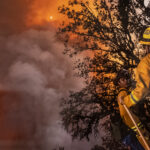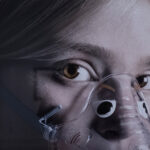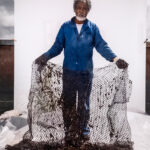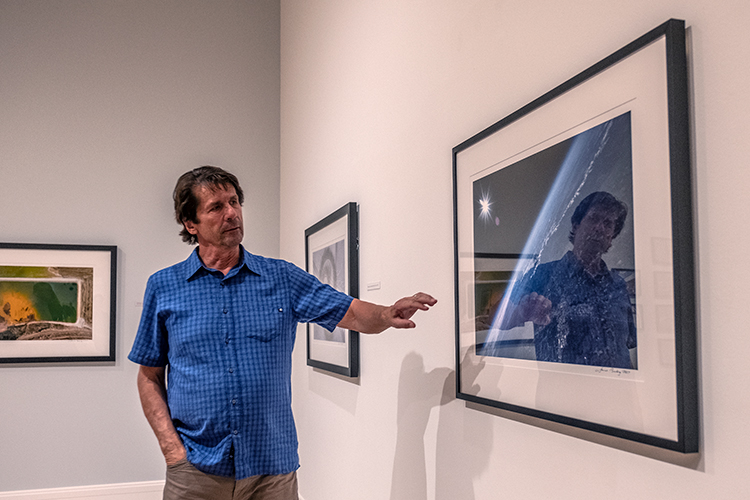
A spectacular photographic exhibition at the Vero Beach Museum of Art – Changing Nature: A New Vision – features stunningly beautiful, and often alarming, photographs by renowned photographer, filmmaker, scientist and author James Balog.
On display in the Holmes and Titelman Galleries through Dec. 31, the show’s four thematic sections – Survivors, Transformation, Combustion and Extraction – reflect four decades of projects, and include work from his book, “The Human Element: A Time Capsule from the Anthropocene.”
Photographs in the Titelman Gallery, Balog says, best illustrate Anthropocene, a geological epoch denoting the human impact on geology and ecosystems.
“If you’re not familiar with the word, Anthropocene is kind of the key to the whole puzzle. The word Anthropocene wasn’t invented 40 years ago when I started looking at this collusion between humanity and nature, but the idea was there,” says Balog.
“The notion is that humanity has had such a profound impact on the rest of the natural environment, that we’re leaving an imprint that will last indefinitely as a geologic epoch.”
Discussions surrounding the Anthropocene marker date vary widely, from the start of agriculture 10,000 years ago, to the beginnings of the Industrial Revolution in the 1800s, nuclear testing in the 1940s and even the age of plastics, 1960s onward.
“My favorite one is agriculture, because that had such a profound impact on reshaping the surface of the earth. The Industrial Revolution reshaped the air supply; that’s when the big modification of the air began,” says Balog.
Referencing “Keystone Power Plant and Farm” taken in Shelocta, Pa., in 2017, he says, “Of all the pictures that are in this show, this picture captures the Anthropocene the best, because this is a coal-fired power plant and that’s agriculture. The landscape and the air above it are totally modified. In my office, we call this my Norman Rockwell.”
While charming as an Americana artwork, the confluence of tranquil farmland and a classic red barn set alongside smokestacks spewing fossil-fueled pollution is jarring.
Balog went to great lengths, as with his other works, to capture the remarkable “Thin Atmosphere Seen from Balloon Camera at 70,000 feet over Denver, Colorado” taken in October 2017.
“The astronauts see the atmosphere all the time like this, but I wanted to have an experience of my own that showed me how thin the atmosphere was.”
Balog attached cameras to a weather balloon that rose to some 99,000 feet (commercial flights are about 36,000 feet). The camera continually snapped away until the balloon exploded and it “dropped like a stone” until parachutes opened at about 40,000.
The greatest number of photographs line the walls of the Holmes Gallery; welcomed at the entrance by “Giant Sequoia, Stagg,” taken in 2001 at Camp Nelson, Calif. It is part of the museum’s permanent collection, purchased with funds from Balog’s late parents, James and Alvina Balog.
At 28 feet in diameter at its base and some 270 feet tall, ‘Stagg’ is the fifth largest tree in the world. To shoot it in its entirety, they set up a complicated rigging program of ropes which Balog climbed and, suspended in the space between the tree photographed and the one opposite, took 451 frames as he made his way down. The tiny spec of red in the photos is tree rigger Billy Ellyson.
“These tree portraits were a continuation of the thinking that was in the Endangered Wildlife series. I wanted to celebrate the largest, oldest individuals of various tree species in the United States,” says Balog, who for six years shot trees that have, to date, survived deforestation.
For the Fire series, Balog made studies at a Forest Service research lab in Montana until a wildfire burned 6,000 acres within a half-mile of his home, in the foothills of the Rockies. He then trained as a wildland firefighter and chased wildfires for four years.
The largest fire piece in the show, “Controlled Burn #6,” was taken in Canada’s Northwest Territories, the rest in the United States.
The Endangered Wildlife series juxtapositions endangered, threatened and vulnerable animals in unexpected poses outside their natural habitat such as “Mandrill, 1989.” There, against a white backdrop, a mandrill faces the camera seated oh-so-casually on a stool, with one leg bent at the knee and the other hanging down.
“I had a math professor who sat like that,” Balog says with a chuckle. “We try to create these barriers and philosophy in our brains that separate us from nature, but to me, when you see a chimpanzee stand up in a very insecure, fragile, human kind of way, you see a lot of humanity.”
That close relationship is accentuated in a series that paired nude models, ranging from ages 5 to 85, with chimpanzees, our nearest genetic relative.
The most iconic is “The Old Man and the Ape.” Posed back-to-back, and not looking terribly dissimilar, the photo personifies that chromosomal connection to the animal kingdom.
A Techno Sapiens series accentuates humans’ connections to technology, such as in “Covid-19 ICU Nurse,” as she resolutely facing the camera in full protective gear; and “Kenny’s Arm, NovaCare-Sabolich Prosthetic & Research Center,” presenting the intricate details of a young man’s transparent prosthetic.
“So this is just a first taste of trying to deal with the morphing of homosapiens into a new creature. The modification of the world isn’t just unique to what we’re imposing on animals. We are modifying the terms of our biological lives through the infusion of technology and technological behaviors in our world.”
And then there are the striking photographs from his Extreme Ice Survey, which clearly and dramatically illustrate the very real alterations of the earth caused by climate change and how quickly global warming is altering glaciers.
“When you melt glaciers, oceans rise. It’s very simple. The tragedy of the world is that kids are going to be living with it in the future,” said Balog. “I was interested in trying to do some sort of photographic exploration of receding glaciers.”
Wanting to photographically explore the world’s receding glaciers, Balog and his team risked life and limb to bolt time-lapse cameras into bedrock at glaciers in Alaska, Northern Canada, Greenland, Iceland, Nepal and Antarctica. Cameras clicked away for many years, amassing an astonishing archive of 1.72 million frames that are headed for the Library of Congress and the National Snow and Ice Data Center.
Some of those breathtaking photos made it into his award-winning documentary “Chasing Ice,” which clearly illustrates the glaciers’ diminishing fates. Some that were photographed are receding but still exist; others are gone forever.
Referencing a collection of “Ice Diamond” photographs, he says, “As glaciers break into smaller and smaller pieces, each one of those pieces becomes part of global sea level rise. It’s not abstractions; these things all connect. As the larger chunks of ice get smaller, they turn into what I was calling ice diamonds. I did a whole bunch of studies of these beautiful, last surviving fragments of glaciers before they melted.”
Several sequential pairs of photographs shot in Iceland show the landscape’s drastic alteration over short periods of time.
“I shot this originally and thought wow, that’s a cool massive block of ice; it’s like an alligator. And then I went back, and it’s all gone,” said Balog, referencing “Tahumming Glacier, British Columbia, Canada,” shot in September 2008 and August 2017. “It was a huge shock to discover how fast the ice was changing.”
Balog plans to team up with other geologists for Extreme Ice Survey Iceland, so that additional cameras can document future glacial changes.
“Most of the ice will be gone in 100 years and the rest in 200. Even the highest icecap in Iceland, which goes up to almost 6,000 feet, is thinning out at about a meter of thinning per year. It’s been heating up tremendously in recent decades, as we know,” says Balog.
For additional information, visit VBMuseum.org or JamesBalog.com.
Photos by Joshua Kodis

